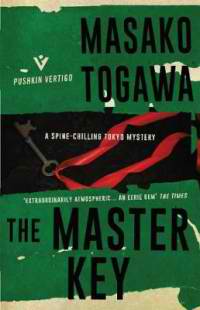The Master Key by Masako Togawa
 Monday, February 5, 2018 at 9:07AM
Monday, February 5, 2018 at 9:07AM 
First published in Japan in 1962; published in translation in 1985; published by Pushkin Vertigo on March 27, 2018
The first chapter of The Master Key establishes a central mystery. The novel then tells a series of interlocking stories about apartment building residents, revolving around nosy neighbors and the secrets they uncover about other residents. The plot is intriguing and suitably mysterious, but the characters (aging women who are driven by loneliness to spy on each other) make this novel special.
The story begins when a man dressed as a woman, wearing a red scarf on a snowy day, is killed in a traffic accident. The woman who was awaiting his return continued to wait. That story dovetails with the kidnapping of a four-year-old child and the burial of a small corpse in the basement of an apartment building.
But before any explanation begins to emerge, the novel introduces some of the residents who occupy the 150 apartments in the ladies’ apartment building where almost all of the story take place. One of those residents has spent years preparing a manuscript of her husband’s academic writings — a manuscript that contains surprising content discovered by a nosey receptionist. Another resident sneaks about at night in search of the heads and bones of fish.
Playing a central role is an elderly violin teacher and the story of a violin that was stolen in 1933. One of the saddest stories involves a former teacher who finds a sense of purpose by writing to each of her former students, giving her an opportunity to reflect on the educational reforms and social changes that followed Japan’s defeat in World War II. The reply she receives from a former student whose son was kidnapped years earlier causes the retired teacher to embark on an investigation of her own, one that involves another retired teacher who lives in the same building.
By stealing the master key to all the rooms, Noriko Tamura learns the secrets of some of the building’s residents. And by stealing it again, Yoneko Kimura learns more secrets. But a priest from the spiritualist Three Spirit Faith sect purports to discover even more secrets (not to mention healing persons and property) through séances that become increasingly popular with the residents.
A wrap-up chapter at the end provides a solution to most of the novel’s mysteries. It ties together the various storylines, leaving no loose ends. The cleverness of the plot construction can’t be fully appreciated until that chapter unlocks nearly all the puzzles — except for the final mystery, which awaits resolution in an epilogue. Suffice it to say that events that seem to be improbable coincidences while the story unfolds are neither improbable nor coincidental by the novel’s end.
As much as I enjoyed the plot, the novel’s real pleasure is the window it offers into the lives of aging women in Japan after World War II. They are nearly prisoners in an apartment building that prides itself on maintaining high moral standards. Many of the central characters rarely leave their rooms; most of those are suffering from what would now be recognized as severe depression. Their nosiness drives the story, but it also creates sympathy for characters who are bored and lonely and wasting away in a society where they are not valued. The novel’s insights into the role of women in post-war Japan adds meaning to the story, making The Master Key more compelling than an ordinary mystery.
RECOMMENDED
 TChris |
TChris |  Post a Comment |
Post a Comment |  Japan,
Japan,  Masako Togawa in
Masako Togawa in  Thriller
Thriller
Reader Comments